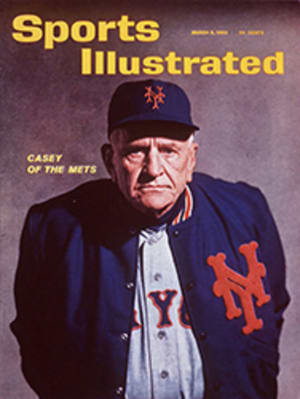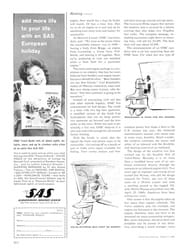
Kilroy was there quite early
In the minds of most West Coast ocean racers the 1,430-mile run from San Diego to Acapulco has a pattern, a traditional formula: you play the beaches, stay close in and work the sea breezes by day and the offshore zephyrs at night, or you haven't got a chance. But this year John (Jim) Kilroy, standing seaward aboard the 50-foot sloop Kialoa in calculated defiance of the formula, not only won the overall prize but set a new corrected-time record in what was, for almost everybody else, a fairly slow race.
On two previous occasions Jim Kilroy had raced Kialoa down the California and Mexican coasts. In 1958 he finished 11th in fleet—as he remembers it, "sitting becalmed everywhere you could get becalmed." Two years later Kialoa moved up to third in fleet, winning her class. After each race Jim Kilroy carefully analyzed performances of the fleets, noting who had benefited by going where. On postrace cruises back home to Newport Beach he studied wind and current patterns. On the evidence Kilroy decided a break with the traditional formula seemed logical.
In preparation for this year's race, Kialoa was first altered to a masthead rig, then converted from a yawl to a sloop by removing the mizzenmast. The sails were subsequently recut to make them draftier for the downwind slide. The net effect of the conversion and refinements was a lower handicap rating, with only a slight loss in efficiency.
By bearing seaward this year, Kialoa's crew not only was breaking with tradition but also, as any West Coast veteran will acknowledge, sacrificing some of the pleasure of the race. The traditional run, hugging the coast, is the only one of the world's classic ocean courses that is a truly scenic route. As the fleet progresses south and east, a magnificent coastline unfolds. Near the Mexican border a jagged range lifts boldly, snow gleaming on the higher peaks. Later there are island channels to run, in an atmosphere so clear that cactus on the steep desert shores of Baja California may be seen through binoculars.
Along the route, as the terrain changes, so do the temperature and the look of the sea. The gray of the north gives way to tropic blue. The cold wind off the mountains loses its bite, becoming merely cool at midnight. Shorts and bare shoulders become the order of every watch. There is usually something worthy of note in the water alongside, especially when crossing the broad mouth of the Gulf of California: sunning sea turtles, the spouts and flukes of basking whales, leaping marlin, darting sea birds. On the Mexican mainland during the last leg there are miles of empty, tempting white beach, finally lifting to the steep cliffs marking the harbor of Acapulco and the finish line.
In a light northwest breeze and patchy fog at the start of this year's race, the eventual winner, Kialoa, looked to be first across the line, with Tim Moseley's Orient virtually abreast. Quickly Orient went into the lead, to begin a duel with the 72-foot yawl Escapade that lasted right down to the finish. Sirius II, scratch boat in the fleet skippered by defending champion Howard Ahmanson, chose a leeward course, setting from her towering 84-foot mast a spinnaker that seemed as big as a circus tent.
A ripping run
For the first three days the fleet had plenty of wind. Sirius damaged three spinnakers in eight hours. "From then on we had to be cautious," said one crew member, "it was like playing basketball with four fouls against you. One more and you're out for good." For 48 hours Sirius' crewmen cranked an ancient sewing machine in an effort to repair the sails. Lack of the right spinnaker for the light winds that followed the heavy prevented the big Class M sloop from opening out on her competitors. Although by the end of the fourth day Sirius had covered 659 miles from San Diego, Orient was only a mile astern.
While most of the fleet hugged the coast to catch the thermal breezes that are born of the alternate heating and cooling of the land, on the 292-mile leg to the San Benito islands Kialoa reached 56 miles to sea before jibing and closing the coast. "Except when it blew hard we never ran off dead before the wind during the whole race," Skipper Kilroy reported. "It was drive, drive, drive the boat all the time." (Twenty-nine spinnaker jibes are recorded in the log.)
Beyond San Benito—where Kialoa had her only all-hands call for an emergency maneuver on closing the island in pitch darkness to find the lighthouse not lighted—a rhumb-line course was laid for Cape San Lazaro to take advantage of smooth water and the wind usually spilling out of Magdalena Bay. Kialoa then followed the coast fairly closely to the tip of Baja California, jibing back and forth for the best point of sailing. Cape San Lucas, at the tip, is a notorious windless trap where the hopes of many early leaders have been buried. In previous races, on the initial legs, the fleet has often opened out like an accordion, with the smaller tailenders more than a hundred miles astern, then in the trap off San Lucas has closed again, practically beginning a new race. Off San Lucas Kialoa hugged the rocky shore, and with nearby Legend, the light-displacement sloop sailed by Charles Ullman, moved steadily into the open waters of the gulf. Legend followed the usual practice, sailing directly across on the shortest course, closing the Mexican mainland near Cape Corrientes. Kilroy here again sacked tradition, bearing Kialoa southward.
Part of Kilroy's strategy was to avoid a foul countercurrent that runs along the coast between Corrientes and Point Telma. "We learned about it the hard way. Two years ago Ash Brown in Carousel gained 34 miles on us overnight by staying offshore." This time it was Kialoa that profited, moving up to fourth position overall in a fleet of 21 boats, a Class B vessel ahead of six of the nine in Class A. At the end of the ninth day she was only 65 miles astern of Sirius, with an allowance of 44 hours over the scratch boat.
Yet even after Sirius crossed the line in Boca Chica passage 9 days 12 hours 52 minutes out of San Diego, there was still an element of doubt. Off the Mexican coast in winter the winds can be very light and fickle indeed. But shortly after Orient and Escapade came in, almost together, at midday, Kialoa appeared over the horizon, her parachute spinnaker a bright bubble on the dark blue. A mile from the finish, aboard Kialoa the cork came out of a bottle of champagne before the report of the committee's cannon had echoed from the cliffs of Acapulco. Kialoa was a happy ship, as well as beautifully sailed.
Legend came up with a freshening afternoon breeze two hours later to drop Orient to second on corrected time in Class A, with the Canadian entry, Spirit, third. Behind Kialoa in Class B were Princess and Mickey. While the bigger boats had managed to keep moving most of the time, there were frustrating periods of calm for the smaller fry.
It was not until late morning of the 12th day that Tommy Wilder brought the 40-foot sloop Malobi across, first finisher in Class C. Malobi subsequently dropped to second in her class when Desert Star arrived well within her handicap. Gamin took third in Class C.
Despite the lack of snorting squalls and gales, the Acapulco race has its own way of testing crews. As an Acapulco race habitué, Sailmaker Kenny Watts, puts it, "The course curves like the rim of a wheel, with the different headlands the spokes, bringing the fleet together all through the race. And because the wind follows the sun, there are lots of sail changes—more fun than sailing to Honolulu because major decisions must be made every few hours."
A skipper to watch
Thirty-nine-year-old Jim Kilroy is a relative newcomer to ocean racing. He had never sailed until 1954, when he bought a 44-foot sloop for puttering around the waters adjacent to Lido Beach. Two years later he acquired Kialoa, and his first long passage aboard her was in the 1957 Honolulu race. He has since sailed twice more to Honolulu, placing second in his class both years. In 1960 he brought a Pacific Coast crew to Rhode Island for the Bermuda race, doing very well in a chartered Block Island 40 until beset by gear failure in the rough blow near the finish. Kilroy is a careful planner and a sound skipper, who stresses the importance of a well-integrated crew. After such a convincing win on his third run to Acapulco, there is not much doubt that he will be a hard man to beat in the future.
"This guy did the impossible," said Howard Ahmanson in a postrace session in the cockpit of Kialoa. "On Sirius we gave up on him after the third day." Kilroy is more modest. "You make your program and your plans," he shrugged, "and if your luck holds, you go." Luck or not, this year Kilroy and Kialoa went fast enough to break the old corrected-time record by five hours.
PHOTO
OVERALL WINNER, Kialoa, makes an easy spinnaker run over the last mile to Acapulco.

